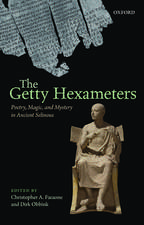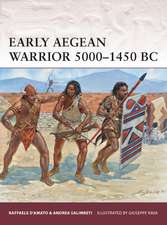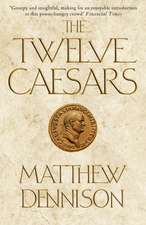Roman Portable Sundials: The Empire in Your Hand
Autor Richard J.A. Talberten Limba Engleză Paperback – 10 mar 2020
| Toate formatele și edițiile | Preț | Express |
|---|---|---|
| Paperback (1) | 361.85 lei 3-5 săpt. | |
| Oxford University Press – 10 mar 2020 | 361.85 lei 3-5 săpt. | |
| Hardback (1) | 445.98 lei 31-37 zile | |
| Oxford University Press – 23 feb 2017 | 445.98 lei 31-37 zile |
Preț: 361.85 lei
Nou
Puncte Express: 543
Preț estimativ în valută:
69.24€ • 72.62$ • 57.64£
69.24€ • 72.62$ • 57.64£
Carte disponibilă
Livrare economică 12-26 martie
Preluare comenzi: 021 569.72.76
Specificații
ISBN-13: 9780197503669
ISBN-10: 0197503667
Pagini: 264
Ilustrații: 99 b/w halftones; 65 b/w line
Dimensiuni: 231 x 165 x 15 mm
Greutate: 0.48 kg
Editura: Oxford University Press
Colecția OUP USA
Locul publicării:New York, United States
ISBN-10: 0197503667
Pagini: 264
Ilustrații: 99 b/w halftones; 65 b/w line
Dimensiuni: 231 x 165 x 15 mm
Greutate: 0.48 kg
Editura: Oxford University Press
Colecția OUP USA
Locul publicării:New York, United States
Recenzii
It is useful to think of this book as the historical counterpart of what in literary studies would be the first major scholarly edition and commentary on a recently discovered text. Talbert writes (p. xiii): 'My hope is that the book will both enlighten and intrigue readers across disciplines by uncovering a fresh, imaginative vision of the world shared by what might be termed a loose community of Romans.' Mission accomplished.
[Richard Talbert] is to be congratulated on producing a fine example not only of microhistory, but also of how to investigate the social and cultural history of science and technology, as opposed to the history of science and technology itself.
The objects are fascinating, and Talbert burrows into the data they present to reconstruct a convincing image of the meaning of the empire's geography to Roman intellectuals.
This fascinating text is recommended for students of the classics, world geography and history, archaeology, and astronomy. ... Summing Up: Recommended. Lower-division undergraduates and above; faculty and professionals.
Richard Talbert's loving study...A short and beautifully illustrated cataglogue is at the heart of the book.
This is a fascinating and eminently scholarly book that is the first to focus attention on this important aspect of Roman timekeeping, and Oxford University Press is to be commended for publishing the many photographs with the clarity required to see the fine details commented upon by the author.
If you open this elegant volume, copiously illustrated with black and white photographs, charts, maps and tables, anticipating 'a technical study' aimed at 'chronometric specialists' (p.3), you will not be disappointed...Although displaying some lighter touches, such as the proposal of Trimalchio as the likeliest sort of person to own a geographical portable sundial (pp.169f.), this study remains primarily a book for scholarly specialists.
Without Richard Talbert's important work over the last decades, any attempt at mapping the ancient world would simply be impossible today. In his new work, he leaves the realm of the Tabula Peutingeriana and zooms into a different kind of evidence: portable sundials. Only a scholar with the experience, detailed knowledge, and ardent love for the classical world, which are the author's hallmarks, could explain how these rare, and rarely studied, artifacts can contribute to a better understanding of the Roman Empire and the people in whose hands they lay."-Kai Brodersen, Professor of Ancient Culture, University of Erfurt
It is hard to imagine that such a pathbreaking book might arise from sixteen small objects. To such rebarbative and seemingly unpromising material the author has brought unmatched cartographic, epigraphic, and cultural historical expertise. The result is fascinating and unexpected insight into everyday geographical knowledge. This book will engage anyone who cares about ancient Roman society, the history of maps, or the history of time-reckoning."-Grant Parker, Professor of Classics, Stanford University
A valuable study of surviving Greco-Roman portable sundials, which offers an original geographical analysis, and neatly places them in their broader historical context. A striking demonstration of how much artifact studies can contribute to the analysis of past societies, and a foundation for all future work."-Anthony Turner, author of Mathematical Instruments in Antiquity and the Middle Ages
[Richard Talbert] is to be congratulated on producing a fine example not only of microhistory, but also of how to investigate the social and cultural history of science and technology, as opposed to the history of science and technology itself.
The objects are fascinating, and Talbert burrows into the data they present to reconstruct a convincing image of the meaning of the empire's geography to Roman intellectuals.
This fascinating text is recommended for students of the classics, world geography and history, archaeology, and astronomy. ... Summing Up: Recommended. Lower-division undergraduates and above; faculty and professionals.
Richard Talbert's loving study...A short and beautifully illustrated cataglogue is at the heart of the book.
This is a fascinating and eminently scholarly book that is the first to focus attention on this important aspect of Roman timekeeping, and Oxford University Press is to be commended for publishing the many photographs with the clarity required to see the fine details commented upon by the author.
If you open this elegant volume, copiously illustrated with black and white photographs, charts, maps and tables, anticipating 'a technical study' aimed at 'chronometric specialists' (p.3), you will not be disappointed...Although displaying some lighter touches, such as the proposal of Trimalchio as the likeliest sort of person to own a geographical portable sundial (pp.169f.), this study remains primarily a book for scholarly specialists.
Without Richard Talbert's important work over the last decades, any attempt at mapping the ancient world would simply be impossible today. In his new work, he leaves the realm of the Tabula Peutingeriana and zooms into a different kind of evidence: portable sundials. Only a scholar with the experience, detailed knowledge, and ardent love for the classical world, which are the author's hallmarks, could explain how these rare, and rarely studied, artifacts can contribute to a better understanding of the Roman Empire and the people in whose hands they lay."-Kai Brodersen, Professor of Ancient Culture, University of Erfurt
It is hard to imagine that such a pathbreaking book might arise from sixteen small objects. To such rebarbative and seemingly unpromising material the author has brought unmatched cartographic, epigraphic, and cultural historical expertise. The result is fascinating and unexpected insight into everyday geographical knowledge. This book will engage anyone who cares about ancient Roman society, the history of maps, or the history of time-reckoning."-Grant Parker, Professor of Classics, Stanford University
A valuable study of surviving Greco-Roman portable sundials, which offers an original geographical analysis, and neatly places them in their broader historical context. A striking demonstration of how much artifact studies can contribute to the analysis of past societies, and a foundation for all future work."-Anthony Turner, author of Mathematical Instruments in Antiquity and the Middle Ages
Notă biografică
Richard Talbert is a Cambridge Classics graduate who taught in the United Kingdom and Canada before becoming Kenan Professor of History at the University of North Carolina, Chapel Hill, where he has established the Ancient World Mapping Center. His many books include The Senate of Imperial Rome, the collaborative Barrington Atlas of the Greek and Roman World, and Rome's World: The Peutinger Map Reconsidered.

















